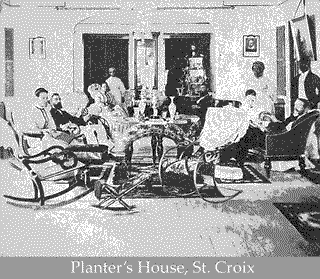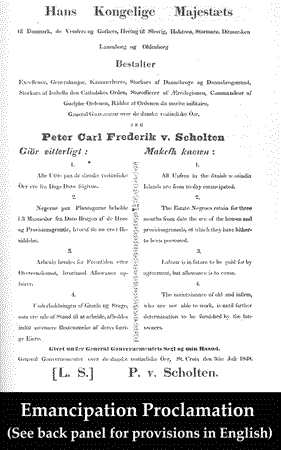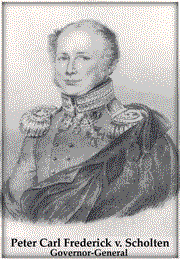St. John’s Week-long 4th of July Festivities Aren’t Just About United States Independence
Under considerable pressure from both home and abroad, in 1847 King Christian VIII of Denmark took the first cautious steps toward emancipation in the Danish West Indies islands of St. Thomas, St. John and St. Croix. On July 28th, he proclaimed that all children born into slavery would from that day on be considered free, and that all unfree in the colony would become emancipated after a twelve-year preparatory period.

While perceived as a sound humanitarian design by insulated bureaucrats in Copenhagen, back in Denmark’s distant West Indian colony, the King’s decree served little else than to heighten the already volatile climate that had existed since emancipation had been declared in the neighboring British West Indies thirteen years earlier [Knox, 1852; Watts, 1987].
For nearly a year the colony simmered; owner and enslaved alike quietly considering their options. Despite words of caution and whispers of insurrection, in the end there was little else to do but let history run its course. A recounting of the earth-shaking events that were soon to unfold on the island of St. Croix is best left to the contemporary chronicler, Dutch Reformed Minister John P. Knox:
…July 2d ushered in the Sabbath morning, with its usual quietness and peace. As the day advanced, tranquil enjoyment and religious feeling seemed to reign throughout the island. Towards evening a commotion was visible; still, but few felt any uneasiness. About eight o’clock, however, there was suddenly a too fearful evidence given that the slaves had risen in rebellion. Simultaneously alarms rang out from many estates as the given signal; and as these alarms rolled on throughout every part of the island, consternation and terror, tumult and uproar, spread on all sides. Fear in its most bitter forms now seized upon the minds of the inhabitants of Frederiksted and the estates contiguous, and many rushed immediately on board the shipping lying in the harbor. Several inhabitants applied to the authorities for orders to resist with the militia force, but they were refused. The night was one of horror, especially to those who were unable to escape from their estates…
At eight o’clock on the morning of the 3d, about two thousand Negroes from the north-side estates marched into town, armed with various weapons. They went directly to the fort, and demanded their freedom. In the absence of the Governor-General, they were told by the officer of the fort, that there was no one who had the authority to grant their request. Their numbers increasing by a band of 3,000 from the south and middle parts of the island and their passions becoming more inflamed from their associated influence, they proceeded to the destruction of property. The police-office and judge’s house were completely sacked… The house of the judge’s assistant shared a like fate. The whipping post met with little mercy; it was uprooted, carried in triumph to the wharf, and thrown into the sea.
At length the Governor-General arrived in his carriage from Christiansted, and entered the fort. A great crowd of Negroes had in the meantime gathered around the walls. There was an intense anxiety on the part of all to know what would be the course of the Governor-General. The commander of the fort repeatedly asked for orders. The Danish man-of-war had sailed from Bassin, and was momentarily expected. At length, to the amazement of the officers and citizens, freedom was proclaimed from the ramparts, by the Governor-General, to all the slaves in the Danish West India Islands.[Knox, 1852]
“All unfree in the danish westindia Islands are from today emancipated [Sic]”
Early on Tuesday morning, July 4th, the schooner Vigilant sailed into St. Thomas harbor bringing news of the uprising and subsequent pronouncement of emancipation on St. Croix. Again, we turn to Pastor Knox for his firsthand observations:

…Great excitement at once prevailed, and this was increased by the proclamation of freedom at the drum-head in the public streets. A crowd of women and boys followed the drum, and shouted and danced merrily; otherwise order prevailed in the town. In the country the proclamation was received by the slaves in the most quiet manner, and all continued at their work…[Knox, 1852]
It was not until Tuesday evening that the owner of Estate Lamesure, Captain Ingjald Mourier, arrived on St. John from St. Thomas bringing the news of Governor-General von Scholten’s decree. After informing Police Master Carl Hanschell of the news, Hanschell and Mourier immediately began circulating the emancipation proclamation throughout the island. Not long after sunset on July 4th, the slaves on estates Adrian and Rustenberg were the first to receive word of there newly-achieved freedom.
The following extract from the Carl Hanschell’s Police Journal describes the situation on St. John as word spread throughout the island on the following day:
5 July, 1848 – The chief constable together with Captain Mourier has continued today proclaiming the emancipation of the unfree at the other plantations on the island. Everywhere the enthusiasm was great and the feelings of the people toward their late owners were generally favorable, chiefly at plantations Leinster Bay and Annaberg, but at a couple of other plantations, namely Klein Caneel Bay, the contrary is the case.[Low & Valls, 1985]

While on St. Thomas and St. John emancipation seems to have been greeted with an almost eerie blend of jubilation and ambivilence the situation on St. Croix was far different. In the days following Governor-General von Scholten’s decree, mayhem prevailed. As the billowing smoke from burning cane fields carried colonial fortunes into the tradewinds, a profound transition was in process. For the people of the Danish West Indies, if there had ever been a point-in-time when the heirs to the hardships and miseries of the Westindiamens’ legacy were to prevail over the wealth and prestige of European colonialism, this was that instant; a moment in the history of the Virgin Islands that will forever be celebrated with pride, jubilation and deep reflection.
To everyone on St. John: have a safe and enjoyable Emancipation Day!
To our visitors: welcome, and thank you for joining us in our celebration of Freedom and United States Independence.
[Emancipation]
